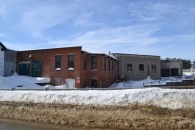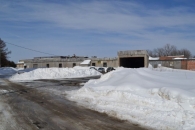Mill Record Stafford
RETURN TO ‘FIND MILLS’Disclaimer: Content for these properties was compiled in 2014-2017 from a variety of sources and is subject to change. Updates are occasionally made under Property Information, however the Connecticut Trust for Historic Preservation (dba Preservation Connecticut) makes no representation or warranty that the information is complete or up-to-date.
- Complex Name (Common)
- Rhode Island Worsted Co.
- Complex Name (Historic)
-
- Rhode Island Worsted Co.
- Address or Location
- 25 West Street, Foxville, Stafford
- County
- Tolland
- Historic Designation
- Associated Mill Community

- Historic Information
Companies Associated w/Complex
- C. Fox & Co. 1851-ca. 1893
- Parley Converse Mill ca. 1837-ca. 1851
- Rhode Island Worsted Co. 1907-1954
- Stafford Printers, Inc. 1940-1981
Use (Historic)
Largest Documented Workforce
500-600 (ca. 1915)
Historic Narrative
The earliest portion of the Rhode Island Worsted Company mill on West Street was erected as a woolen mill by local industrialist Parley Converse ca. 1837. In 1851, the factory was acquired by Charles Fox, who continued the mill into the 1890s as as C. Fox and Company. Fox’s operation was incredibly successful and during his tenure the plant was expanded through the addition of several new manufacturing buildings on both sides of West Street, and construction of numerous tenements for employees in the surrounding area, which became known as Foxville. The C. Fox and Company closed following its founder’s death in 1891, and in 1893 the mill and its machinery was placed on the auction block. A Sanborn map from 1897 indicates that the factory had by that time been acquired by a Samuel Rockwell, and plans were underway to convert the plant for use as a shoe factory. The plans never came to fruition, however, and the mill was not brought back to life until 1907, when it was purchased by the Rhode Island Worsted Company of Indian Orchard, Massachusetts. While the firm initially operated in Massachusetts, it had been incorporated in Rhode Island in 1900 and carried the name of that state throughout its history. The Rhode Island Worsted Company nearly failed during economic crises in 1905 and 1907, yet was financially stabilized after being acquired by a New York banking firm, H.W. T. Mali and Company, which was led by Pierre Mali and Henry L. Cammann. The manufacturer relocated to Stafford in 1907 and dramatically increased the size of its West Street plant through the construction of a new weave shed, dye house, and power plant on the west side of the original mill. Once complete, the new factory was expected to house roughly 300 looms for the manufacture of high-end worsted woolen fabric. The company grew into the largest textile mill in Stafford around the time of the First World War, this largely driven by the success of its “Olympic” line of menswear fabrics, which was produced by its then 500-600 employees. To entice these workers, the company acquired a piece of property north of the plant known as Keefe Plain in 1920, which was developed into a landscaped mill village complete with approximately 25 employee residences, a playground, and baseball park, known as Olympic Field, by 1930. The houses were sold during the mid-1930s, with priority going to company employees. Despite receiving a United States Army “E” Award for its efficient production of military textiles during World War Two, the Rhode Island Worsted Company fell into decline during the 1940s. A portion of the West Street plant was rented to a newly-established firm, Stafford Printers, Inc., starting in 1940, and the older company was eventually forced to cease all operations and sell the plant in 1954. In contrast to the Rhode Island Worsted Company, Stafford Printers experienced great success during and after the Second World War. The company was founded in 1940 by Ernest D. Goodman and Benjamin R. Theise for the production of printed silk fabrics, and thrived during the war years by manufacturing camouflage silk and rayon for parachutes and other purposes. By the end of the war the company had turned out 3.5 million yards, or 200 miles, of such products. While the firm employed 150 workers in 1940, by 1946 this had grown to over 250. Stafford Printers, Inc. operated until 1981 before being forced to close its doors. The West Street plant has since been occupied by a variety of light manufacturing and commercial entities.
- Architectural Information
Number of Existing Buildings
Roughly eight (8) adjoining primary blocks.
Dates of Construction
ca. 1837, ca. 1851, 1907, ca. 1907, 1919, 1963, 1966.
Architect
n/a
Builder
n/a
Building Type
Architectural Description
The former Rhode Island Worsted Company plant is comprised of roughly eight adjoining primary blocks located on the west side of West Street, south of a millpond and the Willimantic River and opposite Center Street. The earliest portion of the plant consists of a three-and-a-half-story, 148’ x 40’ frame manufacturing building erected in ca. 1837. The building’s first story is constructed of coursed ashlar granite and the upper floors are frame. The frame sections of the building are sheathed with vinyl siding, yet they retain their wood corner boards, window trim, cornice, and cornice returns. The building has a side-gabled roof intersected by a cross-gable pavilion centered on the east (façade) elevation. Evenly-spaced double-hung windows are found on all of the building’s elevations, those on the upper floors having recently been replaced with vinyl units. The ground-floor window openings have either been boarded up or have a mix of double-hung vinyl windows, multi-pane steel sash, or glass block infill. The earliest addition to the mill was likely completed ca. 1851 and consists of a two-story 56’ x 44’ red brick spinning, dressing, and picking building erected roughly 38’ west of the original block. In 1907 this was incorporated into sprawling one- and two-story flat-roof additions that expanded the plant’s footprint to the north, south, and west. The new construction consisted of a one-story, 165’ x 235’ red brick weave shed with twelve-over-twelve double-hung wood windows; and a one-story, 124’ x 72’ red brick dye house. A one-story boiler house was also built at this time, however, this was demolished during the late 20th century. The Rhode Island Worsted Company plant was further enlarged in 1919, this through the addition of a one-story, 72’ x 165’ red brick building with three clerestory monitors extending the length of its roof. This structure was used for reeling and spooling activities and abuts the western elevation of the aforementioned weave shed. Another round of additions to the mill were completed during the 1960s. They include several concrete block or steel-frame structures built on the north, south, and west side of the early-20th century portions of the plant. This new construction has multi-pane steel sash, plain wood or concrete cornices, and flat roofs.
Exterior Material(s)
Structural System(s)
Roof Form
Roof Material
Power Source
Condition
Fair, Deteriorated
Condition Notes
The factory is in fair to deteriorated condition. The original mill is currently undergoing rehabilitation, with wood trim having recently been repainted, and new vinyl siding and double-hung windows installed. Later additions to the factory are characterized by a variety of conditions. The walls of several red brick blocks erected directly west of the original building ca. 1907 show some signs of deterioration, while additions built during the second half of the 20th century are in better shape.
- Property Information
-
Specific Location
One 9.53-acre parcel (25 West Street) on the west side of West Street, south of a millpond and the Willimantic River and opposite Center Street.
Adjacent To
Exterior Visible from Public Road?
Yes
Parcel ID / Assessor Record Link
- 48/ / 30 / Link →
Acreage
9.53
Use (Present)
- Commercial
- Industrial
- Other: For sale 1/2023
- Vacant
- Sources
-
Form Completed By
Lucas A. Karmazinas
Date
02/24/2015
Bibliography
- Map of Tolland County, Wm. C. Eaton & H.C. Osborn, 1857.
- Atlas of Tolland County, O.W. Gray, 1869.
- Sanborn Map Company, 1884, 1892, 1897, 1911, 1921, 1930, 1943.
- Aerial Survey of Connecticut, 1934, 1965.
- Birdseye View of Stafford Springs, Conn., O.H. Bailey & Co., 1878.
- List of Connecticut Manufacturers, 1922, 1924, 1930, 1932.
- Directory of Connecticut State Manufacturers, 1936, 1939.
- Industrial Directory of Connecticut, 1947.
- Register of War Production Facilities in Connecticut, 1951.
- Hartford Courant, 1893, 1907, 1919, 1922, 1923, 1946, 1953, 1967, 1980, 1986.
- History of the Town of Stafford, Stafford Library Assoc., 1935.
- Stafford, Connecticut, 250th Anniversary, 1969.
- Stafford Illustrated, Young, William, 1895.
- Town of Stafford HRI, Gibbs, James, 1993.
- Representative View(s)Click on image to view full file








